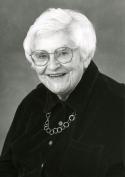On April 5, medicine lost one of its most distinguished physician-scientists with the death of Helen Ranney, a week short of her 90th birthday. In an era when we debate if any of us in medicine can still combine the famous triad of research, teaching, and patient care, she exemplified a quartet of skills that also included superb administrative abilities.
Further, Dr. Ranney developed and implemented these skills at a time when women were almost never accepted as major players in medicine — as she discovered in the rejection of her medical school application in 1941 when she graduated from Barnard College — but fortunately moving into an era of markedly increasing equity with regard to gender. As much as anyone, she was the role model for this equity by becoming the first woman to hold the title of chair of a department of medicine as well as the first woman president of both the American Society of Hematology and the Association of American Physicians.
In 2008, The Hematologist published a brief summary of Dr. Ranney’s many accomplishments. We refer readers to this excellent article for its scientific information as well as vignettes and photographs. Below we add some further personal observations about her as a role model: for one of us in what is now called translational research and for the other as a clinician-teacher.
In her research role spanning almost 50 years, Dr. Ranney published slightly fewer than 100 papers. These studies range from sophisticated physical chemistry, to developing new techniques, to ground-breaking clinical observations. She pioneered the identification and routine clinical detection of new hemoglobin variants, the relevance of hemoglobin A1c to diabetes, and the study of intracellular protein interactions (in the red cell). Her research always went from the patient to the laboratory and back to the patient, not the "bench to bedside" model of today. When Dr. Ranney moved in 1960 from the Columbia University College of Physicians and Surgeons, where she had done all of her training, to Albert Einstein Medical College, she had the foresight to name her unit the "Heredity Clinic," foreshadowing the much later widespread development of medical genetics units.
As a clinician, Dr. Ranney kept abreast of the whole spectrum of hematology and even of internal medicine. Her skill in exploring the limits of knowledge of medical students, residents, and even hematology fellows at the patient’s bedside, without embarrassments, was legendary. She delighted in the fact that the advances in hematology research had made it comparable in rigor to the physiological specialties, such as cardiology and nephrology, and that hematology could no longer be dismissed as "internal dermatology." However, she always remained cautious about the ever-changing contemporary enthusiasms of our profession for various claims of medical breakthroughs.
In 1973, the year that she was elected to the National Academy of Sciences, Dr. Ranney began her 13-year tenure as chair of the Department of Medicine at the relatively new University of California at San Diego (UCSD) School of Medicine. She is widely credited with molding this fledgling school into a strong academic institution and then holding it together despite the effects of another era of political turbulence in the state of California. The chair in medicine at UCSD is now designated as the Helen M. Ranney Distinguished Professor.
Dr. Ranney was the first woman to be named a Distinguished Physician of the Veterans Administration. After she stepped down from the position at UCSD, she remained active in the Veterans Administration Hospital. She also continued her work on the development of potential red blood cell substitutes for transfusion therapy. But in addition to these activities, she was always sought after as a consultant and remained uniquely savvy about topics such as the future of the National Institutes of Health Clinical Center, the development of separate hospitals for individual subspecialties, and many other issues that will affect academic medicine in the decades to come. There are very few individuals, in the past or now, who have had the impact that she did on our profession in general and hematology in particular.

